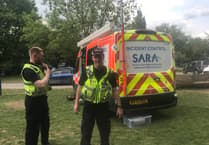ANOTHER former miner has staked his claim to being the Forest’s oldest pitman – 70 years after last going underground.
Milkwall’s Ron White, aged 95, started quarrying at 14 in 1937, went down the mines two years later and finally became a Freeminer 57 years on at the age of 73.
Last week, the Review carried the story of Ruardean’s Les Ruck, who has just become a Freeminer at 92 – 77 years after first going underground.
But Whitecliff-born Ron is three years older and says: “I guess that probably makes me the oldest miner around here. It’ll take some beating anyway.”
Ron was made the 4,331st Freeminer in June 1996, with new-man Les becoming the 4,369th, exactly 180 years this month since registers were first kept.
To be made a Freeminer – a tradition dating back centuries – a person must be born and living “within the Hundred of St Briavels”, be over 21 and must have worked for a year and a day in a mine.
Freeminers can stake their claim to their own mine or quarry in the Forest, and start digging for coal, iron ore, stone and other minerals.
Ron worked at Cannop Colliery, where he was photographed for a war effort publicity campaign, and later independent mines before leaving the industry in 1948, but it was nearly half a century before he decided to obtain his Freeminer certificate.
“They were talking about opening a new open cast pit at Parkend, and I thought why not be a Freeminer, it’s my birthright. It’s a real honour, a part of Forest history.”
But Ron, who has a pin sharp memory of his mining days and loves reading about local history, admits he had no intention of mining again, after three of his workmates all perished in separate accidents at the Cannop Colliery.
“There was great camaraderie, but it was dirty, dangerous work. James Bullock died in my first two weeks, while George Smith – from the same street, Tufthorn Avenue over the road – also lost his life in a rock fall. And then Les ‘Bang’ Jones was killed.
“We had no helmets or battery lamps, just a back-to-front cap with cord holding a carbide lamp, and often worked in mud and water. The roads were so low, holes were cut between the sleepers for the ponies to step in to stop their collars hitting the roof.”
Father-of-three Ron, who has four grandchildren, five great-grand-children and two great-great-grandchildren left school at 14 to work at Bixhead Quarry in Broadwell as a call boy, passing instructions between the quarrymen below and the crane driver 150ft up.
“I was paid just 8 shillings and sixpence a week (42.5 pence),” he recalled. “The pay was so low, I decided two years later to try the mines, where my mother’s family, the Preeces of Broadwell, had worked since the early 1900s.
“I started tramming – running the 880cwt coal trams from the coal face to Fred Hughes, Allan Lodge and Jack Hawkins on Mark Sleeman’s shift. I can recall all the names and that I got paid 5s 10d per shift (29 pence).
“Then later I became a horse driver with Walford, Stow, Prince and Tinker, the white horse - I don’t remember Les at Cannop, but perhaps he’ll recognise the names as he started out at the stables.
“I left in 1946 to work at the Haywood drift mine in Cinderford, and also worked in Mile End and Hangerbury mines. Then I got married to Marjorie in 1947, who I spent 70 happy years with until she passed away last year, and decided to get out of the mines in 1948.
“I did some book learning, and got a job with HW Carter, which became Beechams, where I helped set up the Coleford factory’s first squash operation in 1950 and rose to be a quality control supervisor.”
Having left the mines 70 years ago, Ron joked: “I’d rather call myself the youngest Freeminer than the oldest, but it’s an honour being part of the tradition.
“But I wouldn’t want my family going down the pit and probably wouldn’t be a collier, with all the accidents and illnesses, given my life again.”




